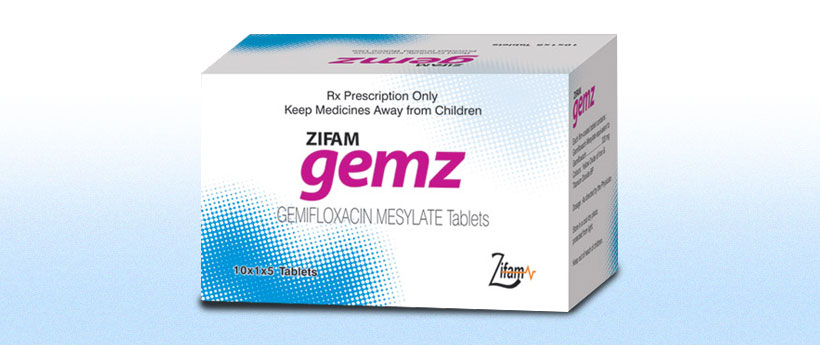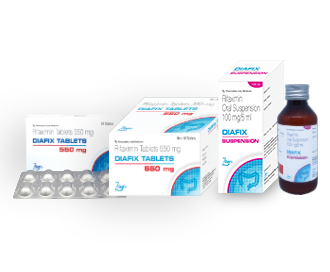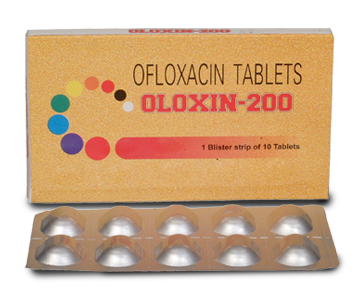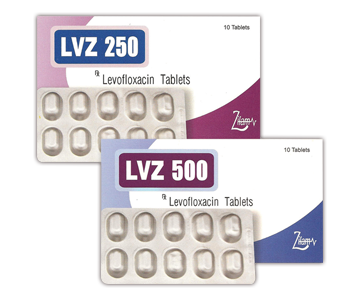Zifam Gemz
- ENG
- မြန်မာ

Gemifloxacin Mesylate Tablets
Composition:
Each film coated tablets contains:
Gemifloxacin Mesylate Equivalent to Gemifloxacin…….320mg
Colours: Yellow Oxide of Iron & Titanium Dioxide BP
Indications:
Zifam Gemz is indicated for the treatment of infections caused by susceptible strains of the designated microorganisms in the conditions listed below. Acute bacterial exacerbation of chronic bronchitis caused by S.pneumonia, Haemophilus influnzae, Haemophilus parainfluenzae, or Moraxella catarrhalis. Community-acquired pneumonia(of mild to moderate severity) caused by S.pneumoniae (including multi-drug resistant strains, Haemophilus influenzae, Moraxella catarrhalis, Mycoplasma pneumoniae, Chlamydia pneumoniae, or Klebsiella pneumoniae.
Dosage and Administration:
ZIFAM GEMZ TABLETS can be taken with or without food and should be swallowed whole with a liberal amount of liquid. The recommended dose of ZIFAM GEMZ TABLETS is 320mg daily, according to the following table.
Recommended Dosage Regimen of ZIFAM GEMZ TABLETS
The clinical decision regarding the use of a 5 day or 7 day regimen should be guided by results of the initial sputum culture.
| INDICATION | DOSE/DURATION | |
| Acute bacterial exacerbation of chronic bronchitis | One tablet daily for 5 days | |
| Community-acquired pneumonia (of mild to moderate severity) | ||
| Due to known or suspectedS.Pneumoniae,
H.influenzae, M.pneumoniae, or C.pneumoniae infection |
One tablet daily for 5 days | |
| Due to known or suspected MDRSP*,K.pneumoniae, or M.catarrhalis infection | One tablet daily for 7 days | |
| *MDRSP: multi-drug resistant Streptococcus pneumoniae, include isolates
Previously known as PRSP (Penicillin-resistant Streptococcus pneumoniae), and are strains resistant to two or more of the following antibiotics: penicillin(MIC=2g/ml), 2nd generation Cephalosporins(e.g., cefuroxime), Macrolides, Tetracyclines and Trimethoprim/Sulfamethoxazole.
|
||
The recommended dose and duration of ZIFAM GEMZ TABLETS should not be exceeded as per the table below
Rash Incidence in ZIFAM GEMZ TABLETS Treated Patients from the Clinical Studies Population* by Gender, Age, and Duration of Therapy
| Gender & Age(yr)Category | Duration of ZIFAM GEMZ TABLETS Therapy | |||
| 5 days | 7days | 10days | 14days | |
| Female<40 | 10/399 (2.5%) | 49/407(12.0%) | 20/131(15.3%) | 7/31(22.6%) |
| Female³40 | 30/1438(2.1%) | 34/887(12.0%) | 19/308(6.2%) | 10/126(7.9%) |
| Male<40 | 6/356 (2.5%) | 26/453(12.0%) | 7/74(9.5%) | 3/39(7.7%) |
| Male³40 | 10/1503(2.5%) | 26/984(12.0%) | 9/345(2.6%) | 3/116(2.6%) |
| Totals | 56/3696(2.5%) | 135/2732(12.0%) | 55/858(6.4%) | 23/312(7.4%) |
*Includes patients from studies of community-acquired pneumonia, acute bacterial exacerbation of chronic bronchitis, and other indications
**exceeds the recommended duration of therapy
Use in Renally Impaired Patients: Dose adjustment in patients with creatinine clearance > 40ml/min is not required. Modification of the dosage is recommended for patients with creatinine clearance= 40ml/min. Table 5 provides dosage guidelines for use in patients with renal impairment.
Recommended Doses for Patients with Renal Impairment
| Creatinine Clearance (ml/min) | Dose |
| >40 | See Usual Dosage |
| £ 40 | 160mg every 24 hours |
Patients requiring routine hemodialysis or continuous ambulatory peritoneal dialysis (CAPD) should receive 160mg every 24 hours.
When only the serum creatinine concentration is known, the following formula may be used to estimate creatinine clearance.
| Men | Creatinine Clearance | Weight (kg) x (140-age)72 x serum creatinine(mg/dL) |
| Women: 0.85 x the value calculated for men | ||
Use in Hepatically Impaired Patients: No dosage adjustment is recommended in patients with wild (Child-Pugh Class A), moderate (Child-Pugh Class B) or servere (Child-Pugh Class C) hepatic impairment.
Use in Elderly: No dosage adjustment is recommended.
SIDE EFFECTS
In clinical studies, 8119 patients received daily or doses of 320 mg ZIFAM GEMZ TABLETS. In addition, 1797 healthy volunteers and 81 patients with renal or hepatic impairment received single or repeat doses of gemifloxacin in clinical pharmocology studies. The majority of adverse reactions experienced by patients in clinical trials were considered to be of mild to moderate severity.
ZIFAM GEMZ TABLETS was discontinued because of an adverse event (determined by the investigator to be possibly or probably related to drug) in 2.0% of patients, primarily due to rash (0.8%), nausea(0.3%), diarrhaea(0.3%), urticaria (0.2%) and vomiting (0.2%). Comparator antibiotics were discontinued because of an adverse event of an overall comparable rae of 2.1%, primarily due to diarrhea(0.5%), nausea (0.4%), vomiting (0.3%), rash(0.3%), abdominal pain(0.2%) and vertigo (0.2%).
The most commonly reported adaverse events with a frequency of ³2%for patients receiving 320mg ZIFAM GEMZ TABLETS versus comparator drug (Beta-Lactam Antibiotics, Macrolides or other Fluoroquinolones) are as follows: diarrhea 5.0% vs. 6.2%; rash 3.5%vs. 1.1%; nausea 3.7% vs.4.5%; headache 4.2% vs. 5.2%; abdominal pain 2.2%; vomiting 1.6 % vs. 2.0%; and dizziness 1.7% vs.2.6%.
CONTRAINDICATIONS:
ZIFAM GEMZ TABLETS is contraindicated in patients with a history of hypersensitivity to Gemifloxacin, Fluoroquinolone antibiotic agents, or any of the product components.
STORAGE:
Store in cool dry place. Protect from Light.
Presentation:
10x1x5 Tablets
Myanmar Reg. No: 1703AA 3845
Manufactured by:
Galpha Laboratories Limited
Village- Thana, Baddi,
Himachal Pradesh – 173 205. INDIA
Product of
Zifam Pinnacle Pty Ltd.
The Healthcare Group








